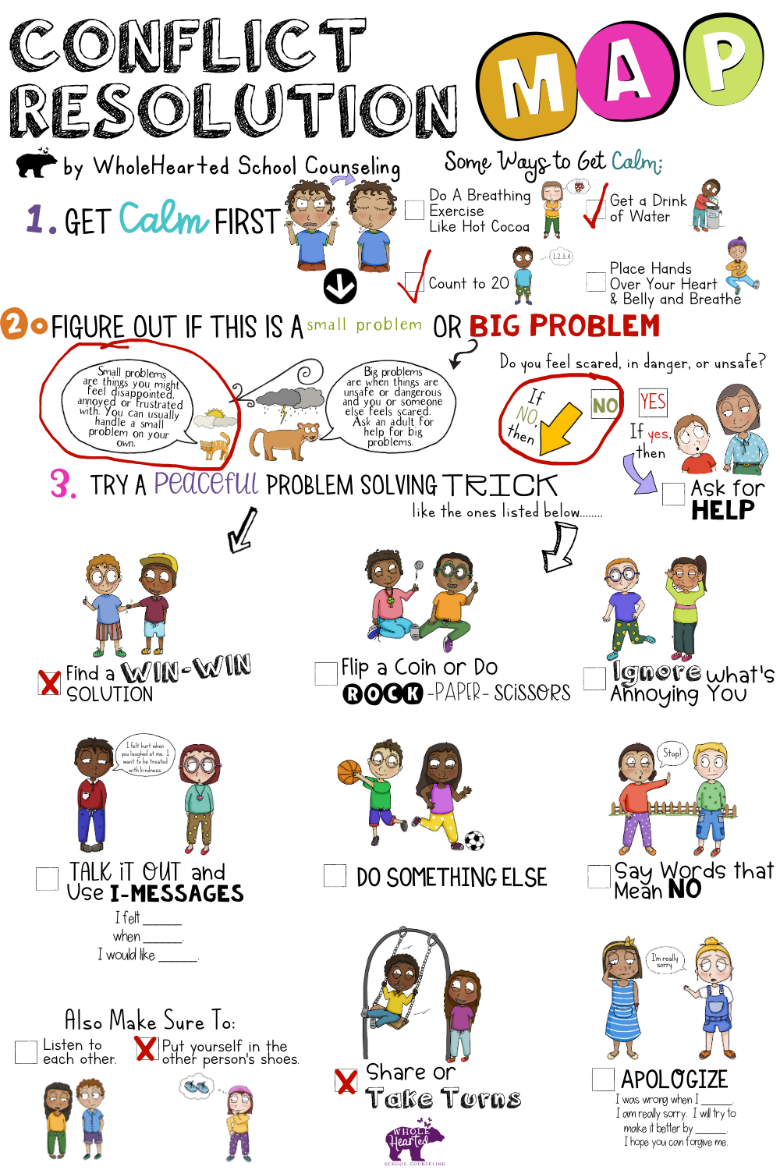Conflict Resolution Techniques for students
Uncategorized Uncategorized
Conflict Resolution Techniques for students
When it comes to the intricate web that is student life, disagreements are unavoidable. It is possible for disputes to manifest themselves in a variety of ways, including disagreements with roommates, disagreements on the direction of a group effort, and tensions between friends. The capacity to resolve these disagreements is an essential talent that not only improves the quality of interpersonal interactions but also contributes to the development of the individual. In this post, we will discuss effective approaches for conflict resolution that are adapted to the specific issues that students confront.
Acquiring Knowledge about Conflict:
At its core, conflict can be defined as a collision of competing interests, values, or objectives. Conflicts can occur from a wide variety of sources in an atmosphere that houses a diverse student body, where individuals come from a variety of different backgrounds and hold a variety of distinct opinions. First and first, in order to successfully resolve conflicts, it is necessary to comprehend and recognise the existence of these disagreements. Students should recognise conflict as an opportunity for growth and learning rather than viewing it as a force that is detrimental to their development.
Listening with Activity:
The practise of active listening is considered to be one of the primary pillars of conflict resolution. Many times, disagreements become more heated as a result of misconceptions or poor communication. By refining the technique of active listening, students can build their skills in dispute resolution and bring them closer together. To accomplish this, one must fully concentrate, comprehend, respond to, and remember what is being said while doing so. Students have the ability to create an atmosphere that is conducive to the peaceful resolution of problems by cultivating a genuine interest in the perspectives of both themselves and others.
Capabilities in Communication:
The ability to communicate effectively is essential to the process of dispute resolution. While maintaining a polite attitude towards others, students should make it a priority to articulate their thoughts and emotions in a way that is both clear and assertive. Therefore, it is essential to make use of “I” statements in order to avoid coming off as accusatory and to concentrate on the particular matter at hand rather than making broad sweeping generalisations. Through the development of their communication skills, students have the ability to lay the groundwork for forthright and honest conversation, so paving the path for settlement.
Intelligent Emotional Competence:
A high level of emotional intelligence is required in order to successfully navigate disputes. It is important for students to be aware of their own feelings as well as the feelings of those who are involved in the conflict. When individuals have a better awareness of the emotional undercurrents, they are able to respond with greater empathy and locate areas of agreement. Having the ability to successfully manage one’s emotions is another component of emotional intelligence. This makes it possible to prevent disagreements from developing into heated arguments.
The art of compromise and negotiation:
Negotiation and compromise are two significant tactics that can be utilised in the field of conflict resolution situations. Students are frequently confronted with circumstances in which the key to finding a resolution is to locate a middle ground. A skill that is extremely valuable is the ability to recognise commonalities in interests and to work together with others to create solutions that satisfy the requirements of all parties concerned. The promotion of a spirit of compromise helps to cultivate an atmosphere of cooperation, which in turn reinforces the notion that disagreements may be handled without the establishment of winners and losers.
Workshops for the Resolution of Conflict:
A proactive role in the enhancement of conflict resolution skills among students can be played by educational institutions and universities through the organisation of workshops and training sessions. Students have the opportunity to strengthen their skills in conflict resolution through the use of these workshops, which can provide them with practical tools, case studies, and simulations. Through the establishment of a learning environment that is encouraging and helpful, educational institutions can equip students with the ability to use these abilities in real-life scenarios.
Intermediary:
In circumstances where disagreements appear to be insurmountable, mediation can be an effective method of conflict resolution. Mediators who have received training, who are typically members of the faculty or professionals, can assist in facilitating productive communication between parties who are in disagreement. Students have the opportunity to voice their concerns, investigate potential solutions, and work towards a settlement that is mutually acceptable through the process of mediation, which provides a neutral ground. It is often possible to break the deadlock and arrive at a conclusion that is more durable by utilising this other perspective.
Case studies: using techniques for conflict resolution in the everyday life of students
Fight Between Roommates:
Consider the following scenario: Sarah and Emma, who share a living space, are always at odds with one another regarding the level of cleanliness and the amount of noise that is present in their shared accommodation. Active listening and open communication are two strategies that can be utilised to resolve this typical dispute that arises among students.
Taking a seat together and attentively listening to one other’s problems without interrupting each other is the first step that Sarah and Emma should take. Through the process of articulating their emotions and points of view, they can come to the realisation that Sarah places a high importance on a peaceful environment for studying, but Emma is more at ease in a more laid-back and social setting. They are able to create clear expectations for cleanliness and noise through excellent communication, which allows them to reach a solution that recognises and satisfies both of their requirements.
Battle of the Group Project:
Differences in working styles and techniques can frequently result in disagreements when it comes to group tasks. Take for example a group of students who are working on a presentation and there are conflicts that occur as a result of different levels of commitment and involvement from the students.
If this is the case, then negotiation and compromise are absolutely necessary. Students are able to hold a meeting with their team in order to discuss the availability, capabilities, and shortcomings of each individual member. It is possible for the group to establish a more equitable division of the burden by identifying shared goals and allocating duties based on individual skills. This will build a culture of collaboration, which will reduce the number of conflicts that occur.
This strain of friendship:
Even while disagreements between friends are unavoidable, they present possibilities for personal development and the strengthening of relationships. Imagine a situation in which two friends, Alex and Jordan, find themselves in a debate regarding the management of their time and the ordering of their priorities.
In this context, emotional intelligence is an important factor to consider. It is necessary for Alex and Jordan to comprehend and acknowledge the emotions that each other is experiencing. Instead than concentrating on assigning blame, they can have an open conversation about their feelings, knowing that the fact that they have different goals does not necessarily mean that their friendship is less valuable. By going through this process, they will be able to gain a more profound comprehension of the perspectives held by each other and locate areas of agreement.
The Dynamics of Leadership in Student Organisations including:
It is also possible for disagreements to occur in positions of leadership within student organisations. Consider a scenario in which the president of a student club, Lisa, and the treasurer, Michael, have disagreements about the decisions that should be made regarding the organisation’s finances.
In situations like these, attending workshops on conflict resolution can be really valuable. Attending a course that focuses on effective communication, decision-making, and conflict resolution within organisational settings is something that Lisa and Michael, along with other club members, have the opportunity to consider doing. It is possible that the shared learning experience may result in a leadership team that is more cohesive, which will subsequently improve the general functioning of the student organisation.
Conflicts among Students:
confrontations in the classroom, such as confrontations over grades or differences regarding the appraisal of group projects, are quite prevalent among students. As an illustration, consider the scenario of a group assignment in which one student, Taylor, believes that the professor did not adequately recognise their contributions.
The use of mediation as a strategy could be appropriate in this circumstance. In order to enable a conversation between Taylor and the professor, a skilled mediator, possibly a member of the faculty, can be of assistance. It is the responsibility of the mediator to ensure that all parties are given the opportunity to share their points of view and to work towards a conclusion that is equitable. In addition to preserving a constructive atmosphere for learning, this external intervention has the potential to stop the escalation of confrontations.
Some Useful Advice Regarding the Implementation of Techniques for Conflict Resolution:
Maintain Your Composure and Calm:
As a quarrel heats up, it is possible for feelings to become intense. It is crucial for students to maintain their composure and direct their attention to the matter at hand, rather than allowing their feelings to become more intense than they already are.
Explore Areas of Agreement:
Identifying shared interests or goals is a good way to locate areas of agreement. While fostering a sense of togetherness and helping to develop a basis for resolution, putting an emphasis on areas of agreement is beneficial.
Put “I” Statements to Use:
To avoid coming across as accusatory while expressing concerns, it is best to explain feelings through the usage of “I” phrases. Saying something like, “I feel frustrated when…” is a more productive approach to express frustration than saying something like, “You always…”
Open Yourself Up to Feedback:
It takes both parties to successfully resolve a conflict. Maintain an open mind to receiving feedback and take into consideration other points of view. This transparency fosters a culture of mutual understanding among individuals.
Taking Lessons from Unresolved Conflicts:
Think back on such disagreements that have been effectively settled in the past. The tactics that were successful should be identified and incorporated into any future efforts to resolve conflicts you undertake.
The development of advanced strategies for conflict resolution and the transformation into proactive peace ambassadors
The Role of Cultural Competence in the Resolution of Conflict:
Students frequently find themselves connecting with classmates that come from a variety of cultural backgrounds now that we live in a globally interconnected world. When it comes to effectively resolving conflicts in situations like these, cultural competence is absolutely necessary. Students should make it a priority to gain an understanding of cultural nuances, conventions, and communication methods. They should also be aware that what members of one culture may deem to be polite may be interpreted differently by members of another generation. The ability to negotiate conflicts with sensitivity is improved by embracing cultural competency, which also contributes to the creation of an environment that is more harmonious.
Interventions Conducted by Peers:
Peer mediation programmes are implemented by several educational institutions. These programmes involve student mediators who have received training to assist their peers in resolving conflicts. With this technique, children are given the ability to play an active role in the settlement of conflicts that occur within their communities. When problems are resolved through the mediation of fellow students, a sense of understanding and relatability is frequently increased, which contributes to more successful outcomes.
Strategies for Resolving Conflicts in Virtual Spaces:
As the landscape of education continues to be reshaped by technology, conflicts are progressively showing themselves in virtual environments at an increasing rate. Platforms for online communication and tools for collaborative work each come with their own different set of obstacles. Students are required to adapt conflict resolution strategies to the digital arena, with an emphasis on online communication that is both clear and polite, virtual mediation, and the use of technology to promote conflict resolution rather than to worsen it.
Mindfulness and techniques for resolving conflicts:
Transformational results can be achieved through the incorporation of mindfulness practises into conflict resolution. Individuals who practise mindfulness are encouraged to devote their complete attention to the present moment, which results in a more profound comprehension of their own feelings and responses. Students have the ability to improve their self-awareness and emotional regulation by introducing mindfulness techniques into their teaching. These practises, which include deep breathing and meditation, can help students become better able to handle conflicts in a constructive manner.
Strategies for the Prevention of Conflict:
The resolution of conflicts is of the utmost importance; nevertheless, it is equally as necessary to avoid conflicts from becoming more serious in the first place. Through the establishment of clear expectations, the promotion of open communication channels, and the proactive attention to possible problems, students have the ability to build solutions for the prevention of conflicts. In order to establish a society in which disagreements are less likely to occur, it is necessary to cultivate a culture that emphasises mutual respect and collaboration.
A Leadership Role in the Resolution of Conflict:
An exceptional chance to serve as a model for good conflict resolution is afforded to students who are in positions of leadership, whether they be in academic settings or within student organisations. Setting an example of open communication, actively pursuing resolutions, and cultivating an environment that is inclusive and supportive are all essential components of leadership in the negotiation and resolution of conflicts. Student leaders contribute to a healthy culture that spreads throughout the entire community by showing these abilities, which resonate throughout the community.
Development of a Community Capable of Handling Conflict:
Individuals have the ability to move beyond their own personal conflict resolution skills and strive towards the goal of developing a community that is conflict-competent. In order to accomplish this, it is necessary to establish a setting in which disagreements are acknowledged as an inherent component of human contact and constructive resolution is regarded as a collective obligation. The establishment of a community that places a high priority on peaceful settlement can be facilitated by activities such as fostering interpersonal communication, organising community-building gatherings, and providing training in conflict resolution.
Initiatives for Education Concerning the Resolution of Conflict:
Through the incorporation of instruction on conflict resolution into the curriculum, institutions have the potential to play a vital role. Students are provided with the skills necessary for academic and personal success through the implementation of this strategy, which guarantees that they will receive formal instruction in procedures involved in dispute resolution. Workshops, seminars, and classes that give in-depth understanding and practical application of conflict resolution principles are examples of educational efforts that might be implemented.
Engaging in Proactive Ambassadorial Activities for Peace:
Within the context of their own educational communities, students have the opportunity to assume the role of proactive peace ambassadors. Students make a good contribution to the cultivation of an inclusive and welcoming atmosphere on campus by actively promoting approaches for conflict resolution. Students have the ability to take the following steps:
Awareness Campaigns for Conflict Resolution Should Be Organised for:
It is important to increase knowledge about the significance of conflict resolution, thus you should launch initiatives. In order to disseminate the message and inspire active engagement, you should make use of a variety of different channels, such as posters, social media, and campus activities.
Peer support networks should be established.
Through the establishment of peer support networks, students will have access to counsel and aid in the process of conflict resolution. One way to accomplish this is by providing student leaders with the training necessary to act as peer mentors and provide assistance to their peers as they navigate issues.
Work in conjunction with the Administration and the Faculty:
Maintain a cooperative relationship with the administration and faculty in order to successfully conduct conflict resolution programmes and seminars. Advocating for the inclusion of conflict resolution education in the curriculum and highlighting the role that it plays in establishing a healthy and constructive learning environment is something that should be done.
By setting an example:
Through your contacts with other people, demonstrate that you understand the fundamentals of conflict resolution. When students demonstrate these concepts in their daily lives, they motivate others to do the same, so fostering an environment in which disagreements are treated with an attitude of understanding and problem-solving.
Encourage participation in initiatives aimed at conflict resolution:
Engage in active participation in activities on campus aimed at conflict resolution. Becoming a member of or providing support for pre-existing programmes, taking part in mediation efforts, and encouraging others to participate in activities aimed at conflict resolution are all examples of what this could entail.
Concluding remarks:
The ability to resolve conflicts is an important talent for students to develop since it not only helps to maintain a peaceful atmosphere in the classroom, but it also helps them get ready for the obstacles they will face in their personal and professional lives that they will encounter thereafter. Students have the ability to successfully manage conflicts if they adopt the strategies of active listening, strengthening communication skills, adopting emotional intelligence, and utilising negotiation and compromise mechanisms. In addition, students who are interested in honing their skills in conflict resolution can benefit from the support of conflict resolution seminars and mediation, which can offer them with significant tools. This post will continue with the following segment, in which we will go deeper into case studies and practical scenarios to highlight the applicability of these strategies in a variety of student contexts.
The settlement of conflicts is an ongoing process that calls for consistent practise, patience, and a dedication to both individual and communal development within the group. Individuals have the ability to change disagreements into opportunities for better understanding, collaboration, and relationships by utilising these approaches in a variety of student circumstances. When students are navigating the intricacies of both their academic and social lives, the ability to master conflict resolution becomes a vital talent that will serve them well beyond the limitations of the educational setting. In the final half of this essay, we will discuss advanced tactics for conflict resolution, as well as the ways in which students can become proactive ambassadors for peaceful settlement in their communities.
As students progress through their academic careers, they have the opportunity to develop a skill set that is both dynamic and ever-evolving: conflict resolution. Students who are able to master both fundamental and advanced approaches not only improve their personal relationships, but they also contribute to the development of communities that are harmonious and resilient. Students have a significant part in shaping the culture of their educational institutions and preparing themselves for the difficulties of the wider world. They are proactive ambassadors for peace, and they play a critical role in both categories. Students are given the ability to face problems with resilience, empathy, and a dedication to developing a society that is more inclusive and cooperative when they embrace conflict resolution as a process of learning that continues throughout their lives.

Geeta Technical Hub
Lorem ipsum dolor sit amet consectetur adipiscing elit dolor
Related Posts

Scope and Career Opportunities after B.Sc. Forensic Science – Geeta University
Scope and Career Opportunities after B.Sc. Forensic Science – Geeta University B.Sc. Forensic Science is a specialized undergraduate program that deals with the application of scientific methods to investigate crime scenes and gather evidence for use in legal proceedings. This
UnderstandingtheService Lifecycle in Service Marketing: A Comprehensive Guide
In the realm of marketing, the concept of the service lifecycle is indispensable, particularly in the context of service-based industries where the intangible nature of offerings poses unique challenges. From inception to delivery, service businesses must navigate through various stages

The Future of Digital Marketing: Trends to Watch – Geeta University
The Future of Digital Marketing: Trends to Watch – Geeta University Digital marketing has transformed the way businesses reach and engage with their customers. As technology continues to evolve at an exponential pace, the future of digital marketing is exciting


